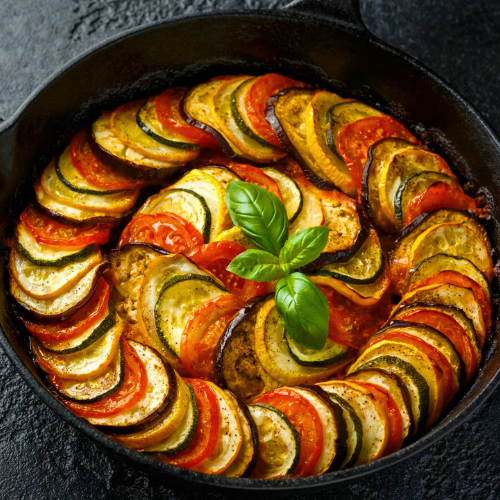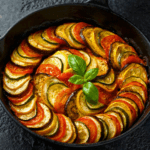How to Make Ratatouille: The Ultimate Guide to This Classic French Vegetable Stew
how to make ratatouille is a rewarding culinary journey that brings the taste of southern France into your kitchen. This colorful, healthy, and versatile dish is perfect for summer or any time you want a light yet flavorful meal.
Table of Contents
- Introduction: What Is Ratatouille?
- Why You Should Make Ratatouille at Home
- Essential Ingredients for Authentic Ratatouille
- Step-by-Step Guide: How to Make Ratatouille
- Tips for Perfect Ratatouille Every Time
- Variations of Ratatouille to Try
- Serving Suggestions and Pairings
- How to Store and Reheat Ratatouille
- Common Mistakes to Avoid When Making Ratatouille
- Health Benefits of Ratatouille
- Frequently Asked Questions (FAQ) About Ratatouille
1. Introduction: What Is Ratatouille?
Ratatouille is a traditional French Provençal stewed vegetable dish, originating from Nice. It’s celebrated for its vibrant colors, rich flavors, and the wholesome combination of summer vegetables such as zucchini, eggplant, bell peppers, tomatoes, onions, and garlic. Often seasoned with herbs like thyme, basil, and rosemary, ratatouille is a delicious, nutritious, and versatile meal that has captivated food lovers worldwide.
The dish gained international fame through the animated movie Ratatouille, where it was portrayed as a sophisticated yet humble recipe that anyone can master. In this article, we will teach you exactly how to make ratatouille step-by-step, ensuring your dish is full of flavor and authentically French.
2. Why You Should Make Ratatouille at Home
- Freshness and Flavor: Homemade ratatouille uses fresh vegetables and herbs, making it far superior to store-bought versions.
- Health Benefits: It’s packed with vitamins, fiber, and antioxidants.
- Versatility: Serve it as a main dish, side, or even a topping for pasta, rice, or bread.
- Easy to Customize: You can adapt the recipe based on your favorite vegetables or dietary needs.
- Impress Guests: Ratatouille looks colorful and tastes gourmet, perfect for entertaining.
3. Essential Ingredients for Authentic Ratatouille
To make classic ratatouille, you’ll need:
- Eggplant (Aubergine): Preferably firm and fresh.
- Zucchini (Courgette): Medium-sized works best.
- Bell Peppers: Use red, yellow, or orange for sweetness and color.
- Tomatoes: Ripe, juicy tomatoes are key.
- Onion: Yellow or white onion adds sweetness and depth.
- Garlic: Freshly minced garlic enhances flavor.
- Olive Oil: Use good quality extra virgin olive oil.
- Herbs: Fresh thyme, rosemary, and basil.
- Salt and Pepper: To taste.
- Optional: Bay leaf or parsley.
4. Step-by-Step Guide: How to Make Ratatouille
Step 1: Prepare the Vegetables
- Wash all vegetables thoroughly.
- Cut eggplant and zucchini into ½-inch cubes.
- Deseed and slice the bell peppers.
- Chop tomatoes finely or crush if you want a softer texture.
- Dice the onion and mince the garlic.
Step 2: Salt and Drain the Eggplant
- Sprinkle eggplant cubes with salt and place in a colander for 20-30 minutes to remove bitterness.
- Rinse and pat dry with a kitchen towel.
Step 3: Cook Each Vegetable Separately
- Heat olive oil in a large skillet over medium heat.
- Sauté onions until translucent.
- Add garlic, cook until fragrant.
- In separate pans, sauté eggplant, zucchini, and bell peppers until tender and lightly browned.
- This step prevents vegetables from becoming mushy when combined.
Step 4: Combine and Simmer
- In a large pot, add sautéed vegetables and chopped tomatoes.
- Add herbs (thyme, rosemary, bay leaf).
- Season with salt and pepper.
- Cover and simmer on low heat for 30-40 minutes, stirring occasionally.
Step 5: Add Fresh Basil and Serve
- Remove the pot from heat.
- Stir in freshly chopped basil.
- Adjust seasoning if needed.
5. Tips for Perfect Ratatouille Every Time
- Use fresh, seasonal vegetables for the best flavor.
- Cook vegetables separately to maintain texture.
- Don’t rush the simmering process — low and slow brings out depth.
- Use a heavy-bottomed pot for even cooking.
- Let the ratatouille rest before serving; flavors deepen over time.
- Serve warm or at room temperature.
6. Variations of Ratatouille to Try
- Ratatouille Tian: Thinly sliced vegetables arranged beautifully in a baking dish and baked.
- Baked Ratatouille: Similar to Tian, baked with cheese topping.
- Ratatouille Pasta: Toss cooked ratatouille with your favorite pasta.
- Ratatouille with Eggs: Crack eggs on top before baking for a one-pan meal.
- Spicy Ratatouille: Add chili flakes or fresh chili for a kick.
7. Serving Suggestions and Pairings
- Serve with crusty French bread or baguette.
- Pair with grilled meats or fish.
- Serve over polenta or rice.
- Use as a topping for pizza or bruschetta.
- Add a dollop of ricotta or goat cheese for creaminess.
8. How to Store and Reheat Ratatouille
- Storage: Keep in an airtight container in the refrigerator for up to 4 days.
- Freezing: Freeze in portions for up to 3 months.
- Reheating: Warm gently on the stove or microwave. Avoid high heat to prevent drying out.
9. Common Mistakes to Avoid When Making Ratatouille
- Skipping the salting step for eggplant: This removes bitterness and excess moisture.
- Cooking all vegetables together: Can result in mushy texture.
- Overcooking: Makes vegetables lose color and become bland.
- Using canned tomatoes: Fresh tomatoes give the best flavor.
- Not seasoning enough: Salt and herbs are essential to bring out flavors.
10. Health Benefits of Ratatouille
Ratatouille is low in calories but rich in nutrients:
- High in fiber from vegetables.
- Loaded with antioxidants from tomatoes, peppers, and eggplants.
- Rich in vitamins A, C, and K.
- Contains heart-healthy olive oil.
- Great for digestion and weight management.
11. Frequently Asked Questions (FAQ) About Ratatouille
What is the best way to cut vegetables for ratatouille?
Cut vegetables into uniform pieces, about ½-inch cubes, to ensure even cooking. For ratatouille Tian, slice vegetables thinly (about ⅛-inch) and arrange in layers.
Can I make ratatouille vegan or gluten-free?
Yes! Ratatouille is naturally vegan and gluten-free as it consists mainly of vegetables and olive oil.
How long does ratatouille last in the fridge?
Stored properly in an airtight container, ratatouille lasts 3-4 days in the refrigerator.
Can I freeze ratatouille?
Yes, ratatouille freezes well for up to 3 months. Thaw in the refrigerator before reheating.
What herbs are best for ratatouille?
Fresh thyme, rosemary, and basil are traditional. Bay leaves can also be added during cooking.
Can I use canned tomatoes for ratatouille?
Fresh tomatoes are preferred for flavor and texture, but canned tomatoes can be used in a pinch.
Is ratatouille served hot or cold?
Ratatouille can be served warm, at room temperature, or chilled, depending on preference.
How do I prevent ratatouille from becoming mushy?
Cook each vegetable separately and avoid overcooking. Simmer gently to maintain texture.
Can I add meat or protein to ratatouille?
While traditional ratatouille is vegetarian, you can add protein such as grilled chicken or sausage as a side or mixed in.
What can I serve with ratatouille?
Crusty bread, rice, polenta, pasta, or grilled meats pair well with ratatouille.
Conclusion
Learning how to make ratatouille is a rewarding culinary journey that brings the taste of southern France into your kitchen. This colorful, healthy, and versatile dish is perfect for summer or any time you want a light yet flavorful meal. Follow the steps, use fresh ingredients, and don’t be afraid to experiment with herbs and seasonings to make your perfect ratatouille.
Enjoy cooking and savor every bite!




